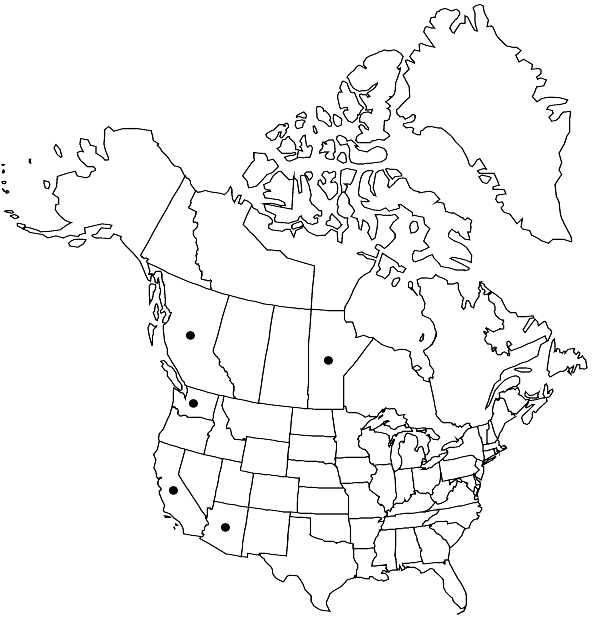Difference between revisions of "Tortula amplexa"
in A. J. Grout, Moss Fl. N. Amer. 1: 233. 1939,.
FNA>Volume Importer |
imported>Volume Importer |
||
| (3 intermediate revisions by 2 users not shown) | |||
| Line 1: | Line 1: | ||
{{Treatment/ID | {{Treatment/ID | ||
|accepted_name=Tortula amplexa | |accepted_name=Tortula amplexa | ||
| − | |accepted_authority=(Lesquereux) Steere | + | |accepted_authority=(Lesquereux) Steere |
|publications={{Treatment/Publication | |publications={{Treatment/Publication | ||
|title=in A. J. Grout, Moss Fl. N. Amer. | |title=in A. J. Grout, Moss Fl. N. Amer. | ||
| Line 9: | Line 9: | ||
|name=Barbula amplexa | |name=Barbula amplexa | ||
|authority=Lesquereux | |authority=Lesquereux | ||
| + | |rank=species | ||
|publication_title=Trans. Amer. Philos. Soc., n. s. | |publication_title=Trans. Amer. Philos. Soc., n. s. | ||
|publication_place=13: 5. 1865 | |publication_place=13: 5. 1865 | ||
| Line 15: | Line 16: | ||
|name=Syntrichia amplexa | |name=Syntrichia amplexa | ||
|authority=(Lesquereux) R. H. Zander | |authority=(Lesquereux) R. H. Zander | ||
| + | |rank=species | ||
}} | }} | ||
|hierarchy=Pottiaceae;Pottiaceae subfam. Pottioideae;Tortula;Tortula amplexa | |hierarchy=Pottiaceae;Pottiaceae subfam. Pottioideae;Tortula;Tortula amplexa | ||
| Line 39: | Line 41: | ||
-->{{#Taxon: | -->{{#Taxon: | ||
name=Tortula amplexa | name=Tortula amplexa | ||
| − | + | |authority=(Lesquereux) Steere | |
| − | |authority=(Lesquereux) Steere | ||
|rank=species | |rank=species | ||
|parent rank=genus | |parent rank=genus | ||
| Line 54: | Line 55: | ||
|publication year= | |publication year= | ||
|special status= | |special status= | ||
| − | |source xml=https:// | + | |source xml=https://bitbucket.org/aafc-mbb/fna-data-curation/src/2e0870ddd59836b60bcf96646a41e87ea5a5943a/coarse_grained_fna_xml/V27/V27_867.xml |
|subfamily=Pottiaceae subfam. Pottioideae | |subfamily=Pottiaceae subfam. Pottioideae | ||
|genus=Tortula | |genus=Tortula | ||
Latest revision as of 21:29, 5 November 2020
Leaves ovate to elliptic, occasionally lingulate, apex rounded and muticuous, margins weakly recurved in proximal 1/2 of leaf, weakly bordered in distal 2/3 of leaf with 2–6 rows of thicker-walled, smaller cells (sometimes weak or patchy); costa percurrent or ending 2–6 cells before the apex, lacking an adaxial pad of cells, distally narrow, 2(–3) cells across adaxial surface; distal laminal cells hexagonal, width 13–18(–25) µm, 1:1, weakly papillose. Sexual condition dioicous. Sporophytes exerted. Seta 0.5–1(–1.5) cm. Capsule stegocarpic, not systylius, cylindric, erect and nearly straight, urn 1.5–2 mm; peristome of 32 twisted filaments, basal membrane low; operculum 1–1.5 mm. Spores 9–13 µm, spheric, essentially smooth.
Phenology: Capsules mature late summer.
Habitat: Soil, stones, near springs, dry washes, lowlands
Elevation: low elevations
Distribution

B.C., Man., Ariz., Calif., Wash., Europe (United Kingdom).
Discussion
Tortula amplexa is similar to T. inermis but the latter is autoicous and lacks the leaf border. The lax areolation, sheathing perichaetial leaves, and weak development of the laminal papillae distinguish it from the similar T. bolanderi. This species is thought to spread by rhizoidal propagula through inadvertent human agency (A. G. Side and H. L. K. Whitehouse 1974).
Selected References
None.